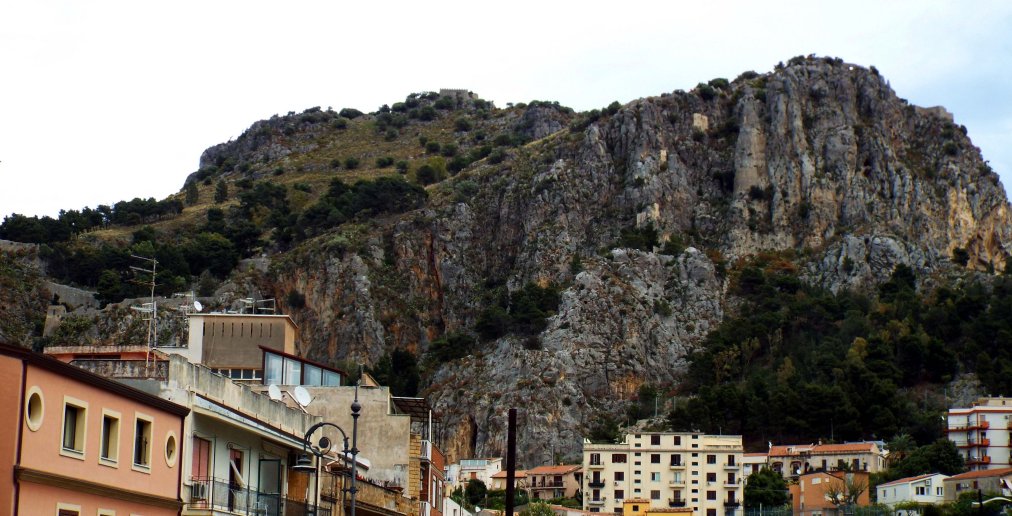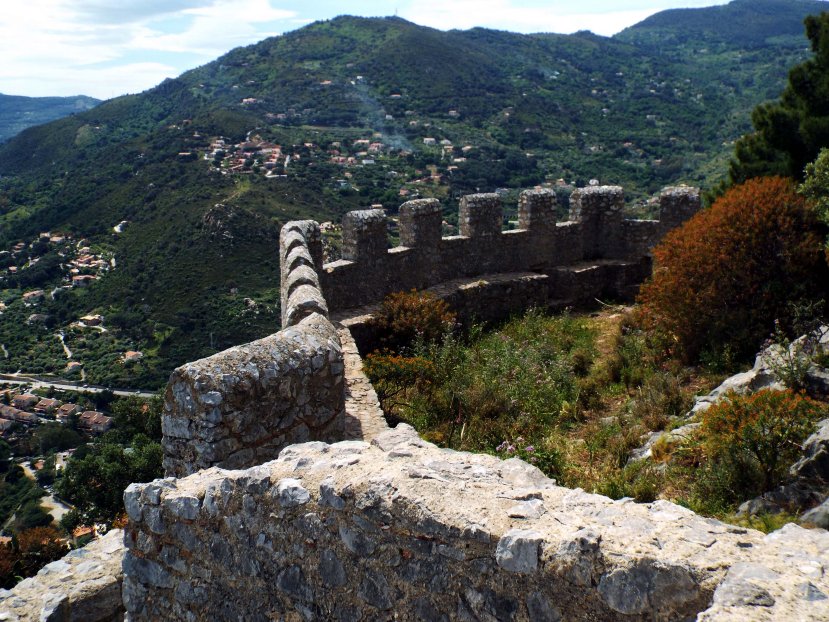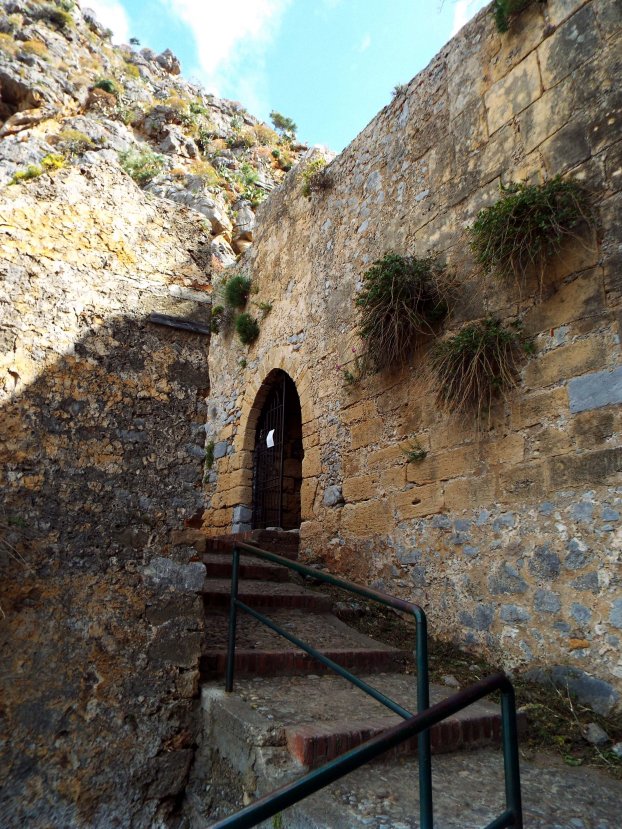Cefalu

In 307 BC Cefalu was conquered by Syracuse and in turn in 254 BC
Cephaloedium fell to the Romans, becoming a part of the province of
Sicily. Cicero, visiting Sicily seeking evidence against Governor
Verre, found the climate sweet. Strabo (d.24 AD) mentioned
Cephaloedium as a small town. At the fall of the Roman Empire the
inhabitants moved to the Rocca leaving the settlement on the west side
of the mountain to decay. However, this was never abandoned
altogether, as evidenced by the mosaics of the sixth century found
under the portico of the duomo/cathedral. In the years 837-838 Cefalu
withstood it's first recorded Muslim attack, but the castle was relieved by
Caesar Alexios Mousele in Spring 838, before his recall the next
year. In 859 Emir Abbas (d.861) captured the rock after he took
Enna that January. He then expelled the residents of Cefalu
mountain and razed the fortress, leaving the area dependent on
Palermo. The Byzantines attempted to retake the site the same year, but were heavily defeated and forced to retire on Syracuse.
The area was plundered by the Normans in 1063 operating from Triona
against the Saracens of Palermo and Enna. It is claimed that they
built
Cefalu castle soon afterwards. Like other places in the
districtb Cefalu was made part of the new diocese of Troina in
1081. In February 1131, the newly crowned King Roger (d.1154)
is said to have landed here after a 2 day storm and founded a
duomo in recompense to God for having survived. By this means
Cefalu, on 14 September, became a major episcopal centre on the island
with a rich and magnificent church. As this is near
the beach and surrounded by a wall, by logical conclusion, the
fortifications on the rock above it must be older. Archbishop
Romuald of Salerno (d.1182) thought that Roger had had the entire city
of Cefalu built, in which he built his beautiful and splendid church of
the Holy Saviour and made the city subject to it.
 Before
1154 Edrisi, in the Book of Roger, while praising Cefalu's amenities
and waters called it a ‘city-like fortress', with merchants,
baths, mills and a castle overlooking the town' from its perch on the
top of a steep mountain which was very difficult to climb. In
1168 the castle was again put to the test. In April Messina
rebelled and seized the castles of Rometta and Toarmina.
Consequently Chancellor Stephen Perche sent the royal usher Andrew to
guard Cefalu castle against the probable disloyalty of Bishop Boso of
Cefalu (d.1172+).
Before
1154 Edrisi, in the Book of Roger, while praising Cefalu's amenities
and waters called it a ‘city-like fortress', with merchants,
baths, mills and a castle overlooking the town' from its perch on the
top of a steep mountain which was very difficult to climb. In
1168 the castle was again put to the test. In April Messina
rebelled and seized the castles of Rometta and Toarmina.
Consequently Chancellor Stephen Perche sent the royal usher Andrew to
guard Cefalu castle against the probable disloyalty of Bishop Boso of
Cefalu (d.1172+).
In 1184 Ibn-Alì-Hasan described the city as defended by a castle
on the cliff, while another Arab in passing commented that ‘set
over the town is a mountain, on whose large circular summit is a
fortress, of which I have never seen one more formidable'.
Cefalu's city walls were
mentioned in a diploma from 1164. Presumably these were the walls
around the duomo. According to the 1170 petition of the chapter
of Cephaludese cathedral to King William II (d.1189), King Roger
(d.1154) had rebuilt the city from its foundations and founded the
cathedral church there. In the late twelfth century the
Andalusian traveller Ibn Jubayr (d.1217) saw ‘a fortress that
never saw another more formidable ... fitted optimally against any
naval army, when suddenly attacked'.
During the early part of the
thirteenth century the bishop of Cefalu and the Emperor Frederick II(d.1250)
argued over possession of city and castle, the dispute
eventually being settled in 1223 by the bishop keeping the city and
Frederick the castle. In 1254 the place rebelled against Peter
Ruffo of Messina (d.1256+) who was looking after Sicily for King Conrad (1250-54).
In 1266 the castle passed to Charles Anjou (d.1285) when he became king, although Henry Ventimiglia of Geraci (d.1308) may have held the fortress against the Crown for a while in 1269-70. In the Angevin registers of 1272 there
is reference to the supply of millet to Castrum Cephaludi.
Presumably this was the castle on the Rocca, rather than the city walls
or the complex made up of both. Certainly on 3 May 1272, the fortress had
the surprisingly large Angevin garrison of 1 squire and 30 sergeants.
During the Sicilian Vespers of 1282 it seems likely that the castle
suffered serious damage when a column was sent against the place from Palermo.
Archeological evidence shows that the castle was probably destroyed by
fire at the end of the thirteenth century. In
August 1284, after the young Charles Anjou (d.1309), later king of
Naples, had been captured, Queen Constance (d.1302) had him moved
to the castle for his safety from the mob. Obviously the castle
was operational then. Once again, in late 1300, the castle served
as the prison for Prince Philip of Taranto for 2 years after he was
captured in single combat by King Frederick III (d.1337) at the battle
of Falconaria near Trapani. Later, during the sixteenth and
seventeenth
centuries, the castle underwent extensive rearrangements. The
castle was finally abandoned with the rest of the mountain top after
the abolition of feudalism in 1812.
 Description
Description
The top of Cefalu Rock, crowned by the castle, now serves as an
archeological city park. The castle is reached via a winding
footpath up the 885' high hill and through two lines of outer
defences, the outermost one of which has ogival arches inserted within
a wall with large megalithic blocks similar to those in the temple of
Diana above and as are found at the ancient works at Erice, Eurialus castle, Palermo old walls and the amphitheatre at Segesta.
There is no portcullis at Cefalu in any of the gates. The city defences consist of the entire vast upper
terrace of the hill which is surrounded by a low curtain wall.
The major remains lie to the north, northwest and southeast. Access is gained from
the town to the west up through a fortified approach to the main line
of fortification around the cliff top. The defences consist of a
low wall, some 8-10' externally, but only 2-3' high internally with
battlements that look modern. In places there is a narrow 2' wide
wallwalk. In other places there are sensible 4' wide wallwalks
and merlons up to 6' above that. The walls vary between 3' and 6'
thick dependent on the amount of threat to the wall due to the
landscape. At the southeast side are 2 rectangular towers commanding the
cliff to the east. Within the lower ward to the west lie the
church of St Anne and the temple of Diana.
Encompassed within the lower curtain and occupying the summit of the
hill are the remains of another large irregular ward, 340' east to west
and 240' north to south. Again modern tradition states that this
is an Arab
fortress. However, the history of the site suggests it is more
likely Byzantine and that Arab fortresses within Sicily were more the
product of historical guesswork, than documentation or archaeological
deduction, viz. Calatabiano, Caltabellotta, Delia and Enna. This
large irregular castle is entered by an inturned gateway at the north
end of the west wall. Such a design is more prehistoric than
medieval, but it also appears at Nicosia. The wall on the cliff
side to the south and east is irregular and thin, following the line of the
cliff, rather like that of the lower ward below. On the interior
side of the summit the wall is thicker reaching some 6'. Within
the enclosure are traces of many buildings, a rectangular chamber or
hall being aligned on the north wall. In the southwest corner of the
enclosure is a rectangular inner ward occupying the highest portion of
the enclosure. This odd structure is sub-rectangular with thick
walls and an entrance to the west protected by a still battlemented low
barbican which joins the curtain wall of the outer enclosure.
Within the ‘ward' are many internal buildings including a vaulted
cistern in the northeast corner. The castle bears comparison with
Calatafimi at Segesta where there is a similar, but generally better
preserved rectangular ward.
Below, the city has 3 gates remaining, the land door, halfway between
the sea and the fortress, the Ossuna gate close to the first bastion by
the sea and now a restaurant, and the Pescara or Marina gate, which
still retains its Gothic arch overlooking the small fishing port.
To the northeast was the Giudecca Gate which has now gone. The cathedral
is accepted as Roger's work between 1131 and 1148, except for the west
front which was thirteenth century, while the city walls were described as new in 1190.
Why not join me at here and at other Sicilian
castles? Information on this and other tours can be found at Scholarly
Sojourns.
Copyright©2019
Paul Martin Remfry


 Before
1154 Edrisi, in the Book of Roger, while praising Cefalu's amenities
and waters called it a ‘city-like fortress', with merchants,
baths, mills and a castle overlooking the town' from its perch on the
top of a steep mountain which was very difficult to climb. In
1168 the castle was again put to the test. In April Messina
rebelled and seized the castles of Rometta and Toarmina.
Consequently Chancellor Stephen Perche sent the royal usher Andrew to
guard Cefalu castle against the probable disloyalty of Bishop Boso of
Cefalu (d.1172+).
Before
1154 Edrisi, in the Book of Roger, while praising Cefalu's amenities
and waters called it a ‘city-like fortress', with merchants,
baths, mills and a castle overlooking the town' from its perch on the
top of a steep mountain which was very difficult to climb. In
1168 the castle was again put to the test. In April Messina
rebelled and seized the castles of Rometta and Toarmina.
Consequently Chancellor Stephen Perche sent the royal usher Andrew to
guard Cefalu castle against the probable disloyalty of Bishop Boso of
Cefalu (d.1172+).  Description
Description